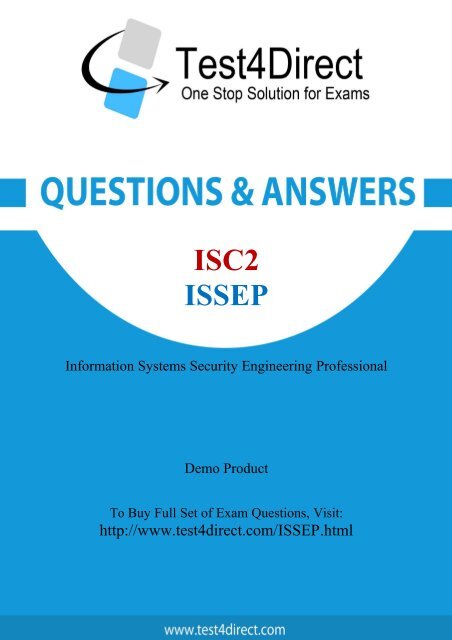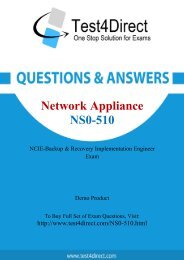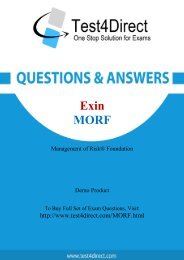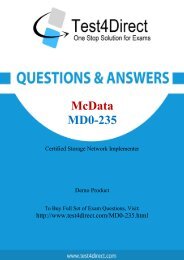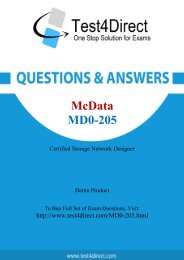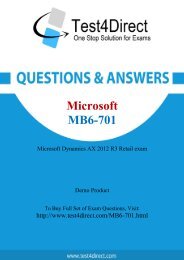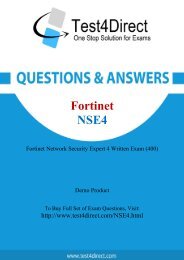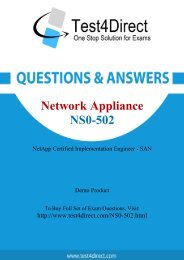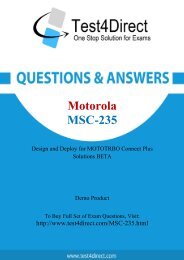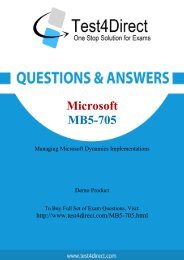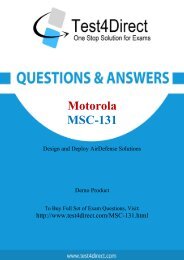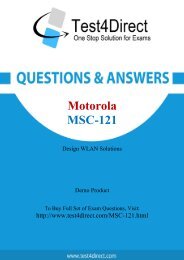ISSEP-demo
Create successful ePaper yourself
Turn your PDF publications into a flip-book with our unique Google optimized e-Paper software.
ISC2<br />
<strong>ISSEP</strong><br />
Information Systems Security Engineering Professional<br />
Demo Product<br />
To Buy Full Set of Exam Questions, Visit:<br />
http://www.test4direct.com/<strong>ISSEP</strong>.html
Question: 1<br />
Choose and reorder the steps involved in the trade-off analysis.<br />
Answer:<br />
Explanation: The steps involved in the trade-off analysis are as follows:<br />
1.Define the problem<br />
2.Identify solutions<br />
3.Identify criteria for deciding on a solution<br />
4.Evaluate the alternatives<br />
5.Decide on the solution<br />
Question: 2<br />
TQM recognizes that quality of all the processes within an organization contribute to the quality of<br />
the product. Which of the following are the most important activities in the Total Quality<br />
Management?<br />
Each correct answer represents a complete solution. Choose all that apply.<br />
A: Quality renewal<br />
B: Quality improvements<br />
C: Quality costs<br />
D: Maintenance of quality<br />
Explanation:<br />
Answer: ABD
The most important activities in the Total Quality Management are as follows:<br />
Maintenance of quality<br />
Quality improvements<br />
Quality renewal<br />
Answer option C is incorrect. The concept of quality costs is a means to quantify the total cost of<br />
quality-related efforts and deficiencies.<br />
Question: 3<br />
Certification and Accreditation (C&A or CnA) is a process for implementing information security. It is<br />
a systematic procedure for evaluating, describing, testing, and authorizing systems prior to or after a<br />
system is in operation. Which of the following statements are true about Certification and<br />
Accreditation? Each correct answer represents a complete solution. Choose two.<br />
A: Accreditation is a comprehensive assessment of the management, operational, and technical<br />
security controls in an information system.<br />
B: Certification is a comprehensive assessment of the management, operational, and technical<br />
security controls in an information system.<br />
C: Certification is the official management decision given by a senior agency official to authorize<br />
operation of an information system.<br />
D: Accreditation is the official management decision given by a senior agency official to authorize<br />
operation of an information system.<br />
Question: 4<br />
Answer: BD<br />
Explanation:<br />
Certification and Accreditation (C&A or CnA) is a process for implementing information security. It is<br />
a systematic procedure for evaluating, describing, testing, and authorizing systems prior to or after a<br />
system is in operation. The C&A process is used extensively in the U.S. Federal Government. Some<br />
C&A processes include FISMA, NIACAP, DIACAP, and DCID 6/3.<br />
Certification is a comprehensive assessment of the management, operational, and technical security<br />
controls in an information system, made in support of security accreditation, to determine the extent<br />
to which the controls are implemented correctly, operating as intended, and producing the desired<br />
outcome with respect to meeting the security requirements for the system.<br />
Accreditation is the official management decision given by a senior agency official to authorize<br />
operation of an information system and to explicitly accept the risk to agency operations (including<br />
mission, functions, image, or reputation), agency assets, or individuals, based on the implementation<br />
of an agreed-upon set of security controls.<br />
Drag and drop the correct DoD Policy Series at their appropriate places.
Answer:<br />
Explanation: The various DoD policy series are as follows:<br />
Question: 5<br />
You work as a system engineer for BlueWell Inc. You want to verify that the build meets its data<br />
requirements, and correctly generates each expected display and report. Which of the following tests<br />
will help you to perform the above task?<br />
A: Functional test<br />
B: Reliability test<br />
C: Regression test<br />
D: Performance test<br />
Answer: A<br />
Explanation:<br />
The various types of internal tests performed on builds are as follows:<br />
Regression tests: It is also known as the verification testing. These tests are developed to confirm<br />
that capabilities in earlier builds continue to work correctly in the subsequent builds.<br />
Functional test:<br />
These tests emphasizes on verifying that the build meets its functional and data requirements and
correctly generates each expected display and report.<br />
Performance tests: These tests are used to identify the performance thresholds of each build.<br />
Reliability tests: These tests are used to identify the reliability thresholds of each build.<br />
Question: 6<br />
Which of the following security controls will you use for the deployment phase of the SDLC to build<br />
secure software? Each correct answer represents a complete solution. Choose all that apply.<br />
A: Vulnerability Assessment and Penetration Testing<br />
B: Security Certification and Accreditation (C&A)<br />
C: Risk Adjustments<br />
D: Change and Configuration Control<br />
Question: 7<br />
Answer: ABC<br />
Explanation:<br />
The various security controls in the SDLC deployment phase are as follows:<br />
Secure Installation: While performing any software installation, it should kept in mind that the<br />
security configuration of the environment should never be reduced. If it is reduced then security<br />
issues and overall risks can affect the environment. Vulnerability Assessment and Penetration<br />
Testing: Vulnerability assessments (VA) and penetration testing (PT) is used to determine the risk and<br />
attest to the strength of the software after it has been deployed. Security Certification and<br />
Accreditation (C&A): Security certification is the process used to ensure controls which are effectively<br />
implemented through established verification techniques and procedures, giving organization<br />
officials confidence that the appropriate safeguards and countermeasures are in place as means of<br />
protection. Accreditation is the provisioning of the necessary security authorization by a senior<br />
organization official to process, store, or transmit information.Risk Adjustments: Contingency plans<br />
and exceptions should be generated so that the residual risk be above the acceptable threshold.<br />
Which of the following CNSS policies describes the national policy on use of cryptomaterial by<br />
activities operating in high risk environments?<br />
A: NSTISSP No. 6<br />
B: CNSSP No. 14<br />
C: NCSC No. 5<br />
D: NSTISSP No. 7<br />
Answer: C<br />
Explanation:<br />
The various CNSS policies are as follows:<br />
NSTISSP No. 6: It describes the national policy on certification and accreditation of national security<br />
telecommunications and information systems.<br />
NSTISSP No. 7: It describes the national policy on secure electronic messaging service.<br />
NSTISSP No. 11: It describes the national policy governing the acquisition of information assurance<br />
(IA) and IA-enabled Information Technology (IT) products.<br />
NSTISSP No. 101: It describes the national policy on securing voice communications.
NSTISSP No. 200: It describes the national policy on controlled access protection.<br />
CNSSP No. 14: It describes the national policy governing the release of information assurance<br />
products and services to authorized U.S. persons or activities that are not a part of the federal<br />
government.<br />
NCSC No. 5: It describes the national policy on use of cryptomaterial by activities operating in high<br />
risk environments.<br />
Question: 8<br />
DoD 8500.2 establishes IA controls for information systems according to the Mission Assurance<br />
Categories (MAC) and confidentiality levels. Which of the following MAC levels requires high<br />
integrity and medium availability?<br />
A: MAC I<br />
B: MAC III<br />
C: MAC IV<br />
D: MAC II<br />
Explanation:<br />
The various MAC levels are as follows:<br />
MAC I: It states that the systems have high availability and high integrity.<br />
MAC II: It states that the systems have high integrity and medium availability.<br />
MAC III: It states that the systems have basic integrity and availability.<br />
Question: 9<br />
Answer: D<br />
Which of the following acts promote a risk-based policy for cost effective security?<br />
Each correct answer represents a part of the solution. Choose all that apply.<br />
A: Paperwork Reduction Act (PRA)<br />
B: Lanham Act<br />
C: Clinger-Cohen Act<br />
D: Computer Misuse Act<br />
Answer: AC<br />
Explanation:<br />
The Paperwork Reduction Act (PRA) and the Clinger-Cohen Act promote a risk-based policy for cost<br />
effective security.<br />
Answer option B is incorrect. The Lanham Act is a piece of legislation that contains the federal<br />
statutes of trademark law in the United States. The Act prohibits a number of activities, including<br />
trademark infringement, trademark dilution, and false advertising. It is also called Lanham<br />
Trademark Act.<br />
Answer option D is incorrect. The Computer Misuse Act 1990 is an Act of the UK Parliament, which<br />
states the following statements:<br />
Unauthorised access to the computer material is punishable by 6 months imprisonment or a fine<br />
"not exceeding level 5 on the standard scale" (currently 5000). Unauthorized access with the intent<br />
to commit or facilitate commission of further offences is punishable by 6 months/maximum fine on
summary conviction or 5 years/fine on indictment. Unauthorised modification of computer material<br />
is subject to the same sentences as section 2 offences.<br />
Question: 10<br />
Which of the following types of CNSS issuances establishes or describes policy and programs,<br />
provides authority, or assigns responsibilities?<br />
A: Policies<br />
B: Directives<br />
C: Advisory memoranda<br />
D: Instructions<br />
Question: 11<br />
Answer: B<br />
Explanation:<br />
The various CNSS issuances are as follows:<br />
Policies: It assigns responsibilities and establishes criteria (NSTISSP) or (CNSSP).<br />
Directives: It establishes or describes policy and programs, provides authority, or assigns<br />
responsibilities (NSTISSD). Instructions: It describes how to implement the policy or prescribes the<br />
manner of a policy (NSTISSI). Advisory memoranda: It provides guidance on policy and may cover a<br />
variety of topics involving information assurance, telecommunications security, and network security<br />
(NSTISSAM).<br />
You work as a security engineer for BlueWell Inc. You want to use some techniques and procedures<br />
to verify the effectiveness of security controls in Federal Information System. Which of the following<br />
NIST documents will guide you?<br />
A: NIST Special Publication 800-53A<br />
B: NIST Special Publication 800-53<br />
C: NIST Special Publication 800-37<br />
D: NIST Special Publication 800-59<br />
Answer: A<br />
Explanation:<br />
NIST has developed a suite of documents for conducting Certification & Accreditation (C&A). These<br />
documents are as follows:<br />
1.NIST Special Publication 800-37: This document is a guide for the security certification and<br />
accreditation of Federal Information<br />
Systems.<br />
2.NIST Special Publication 800-53: This document provides a guideline for security controls for<br />
Federal Information Systems.<br />
3.NIST Special Publication 800-53A: This document consists of techniques and procedures for<br />
verifying the effectiveness of security controls in Federal Information System.<br />
4.NIST Special Publication 800-59: This document provides a guideline for identifying an information<br />
system as a National Security System.<br />
5.NIST Special Publication 800-60: This document is a guide for mapping types of information and
information systems to security objectives and risk levels.<br />
Question: 12<br />
Which of the following NIST Special Publication documents provides a guideline on network security<br />
testing?<br />
A: NIST SP 800-53A<br />
B: NIST SP 800-59<br />
C: NIST SP 800-42<br />
D: NIST SP 800-60<br />
E: NIST SP 800-53<br />
F:NIST SP 800-37<br />
Question: 13<br />
Answer: C<br />
Explanation:<br />
NIST SP 800-42 provides a guideline on network security testing.<br />
Answer options F, E, A, B, and D are incorrect. NIST has developed a suite of documents for<br />
conducting Certification & Accreditation (C&A).<br />
These documents are as follows:<br />
NIST Special Publication 800-37: This document is a guide for the security certification and<br />
accreditation of Federal Information Systems.<br />
NIST Special Publication 800-53: This document provides a guideline for security controls for Federal<br />
Information Systems.<br />
NIST Special Publication 800-53A: This document consists of techniques and procedures for verifying<br />
the effectiveness of security controls in Federal Information System.<br />
NIST Special Publication 800-59: This document is a guideline for identifying an information system<br />
as a National Security System.<br />
NIST Special Publication 800-60: This document is a guide for mapping types of information and<br />
information systems to security objectives and risk levels.<br />
In which of the following phases of the DITSCAP process does Security Test and Evaluation (ST&E)<br />
occur?<br />
A: Phase 1<br />
B: Phase 3<br />
C: Phase 4<br />
D: Phase 2<br />
Answer: B<br />
Explanation:<br />
Security Test and Evaluation (ST&E) occurs in Phase 3 of the DITSCAP C&A process.<br />
Answer option A is incorrect. The Phase 1 of DITSCAP C&A is known as Definition Phase. The goal of<br />
this phase is to define the C&A level of effort, identify the main C&A roles and responsibilities, and<br />
create an agreement on the method for implementing the security requirements.<br />
The Phase 1 starts with the input of the mission need. This phase comprises three process activities:
Document mission need<br />
Registration<br />
Negotiation<br />
Answer option D is incorrect. The Phase 2 of DITSCAP C&A is known as Verification. The goal of this<br />
phase is to obtain a fully integrated system for certification testing and accreditation. This phase<br />
takes place between the signing of the initial version of the SSAA and the formal accreditation of the<br />
system. This phase verifies security requirements during system development. The process activities<br />
of this phase are as follows:<br />
Configuring refinement of the SSAA<br />
System development<br />
Certification analysis<br />
Assessment of the Analysis Results<br />
Answer option C is incorrect. The Phase 4 of DITSCAP C&A is known as Post Accreditation. This phase<br />
starts after the system has been accredited in the Phase 3. The goal of this phase is to continue to<br />
operate and manage the system and to ensure that it will maintain an acceptable level of residual<br />
risk. The process activities of this phase are as follows:<br />
System operations<br />
Security operations<br />
Maintenance of the SSAA<br />
Change management<br />
Compliance validation
THANKS FOR TRYING THE DEMO OF OUR PRODUCT<br />
Visit Our Site to Purchase the Full Set of Actual <strong>ISSEP</strong> Exam Questions With Answers.<br />
http://www.test4direct.com/<strong>ISSEP</strong>.html<br />
We Also Provide Practice Exam Software That Simulates Real Exam Environment And Has<br />
Many Self-Assessment Features. Download Free Product Demo From:<br />
http://www.test4direct.com/<strong>ISSEP</strong>.html<br />
Money Back Guarantee<br />
Check Out Our Customer Testimonials


